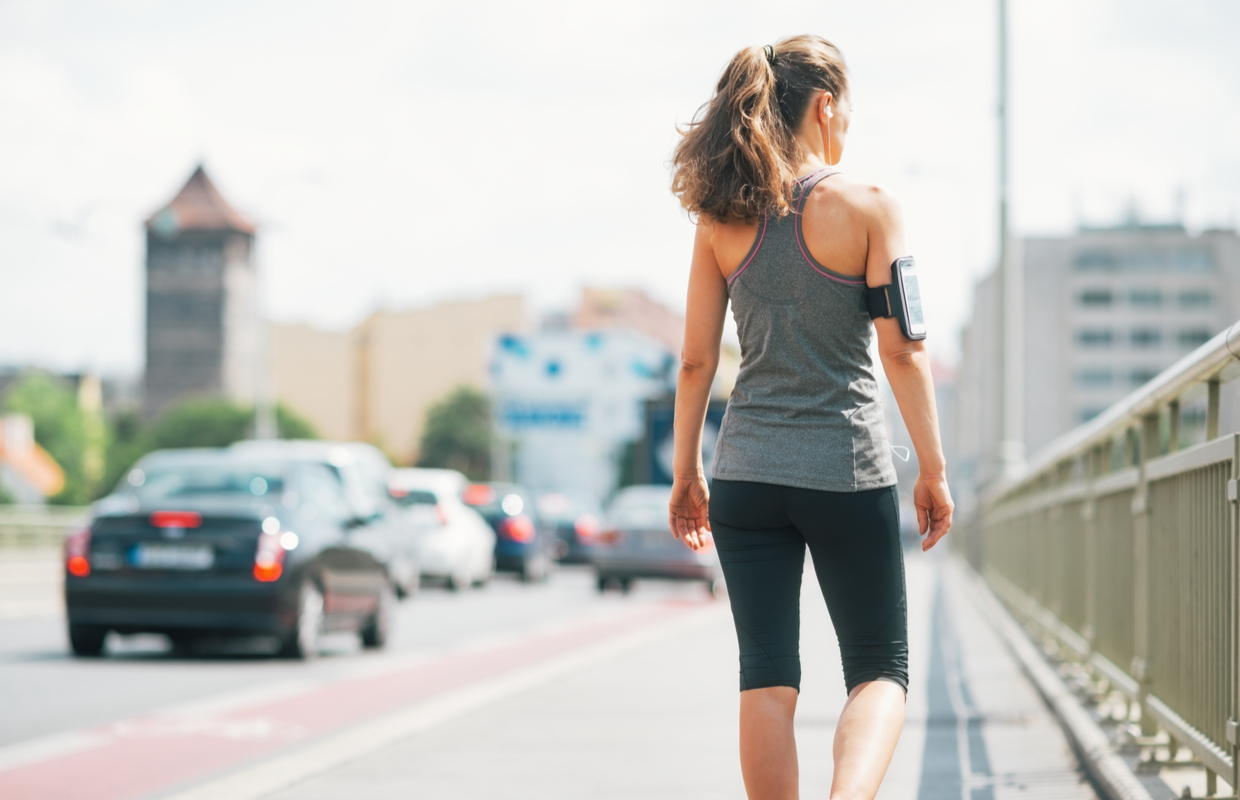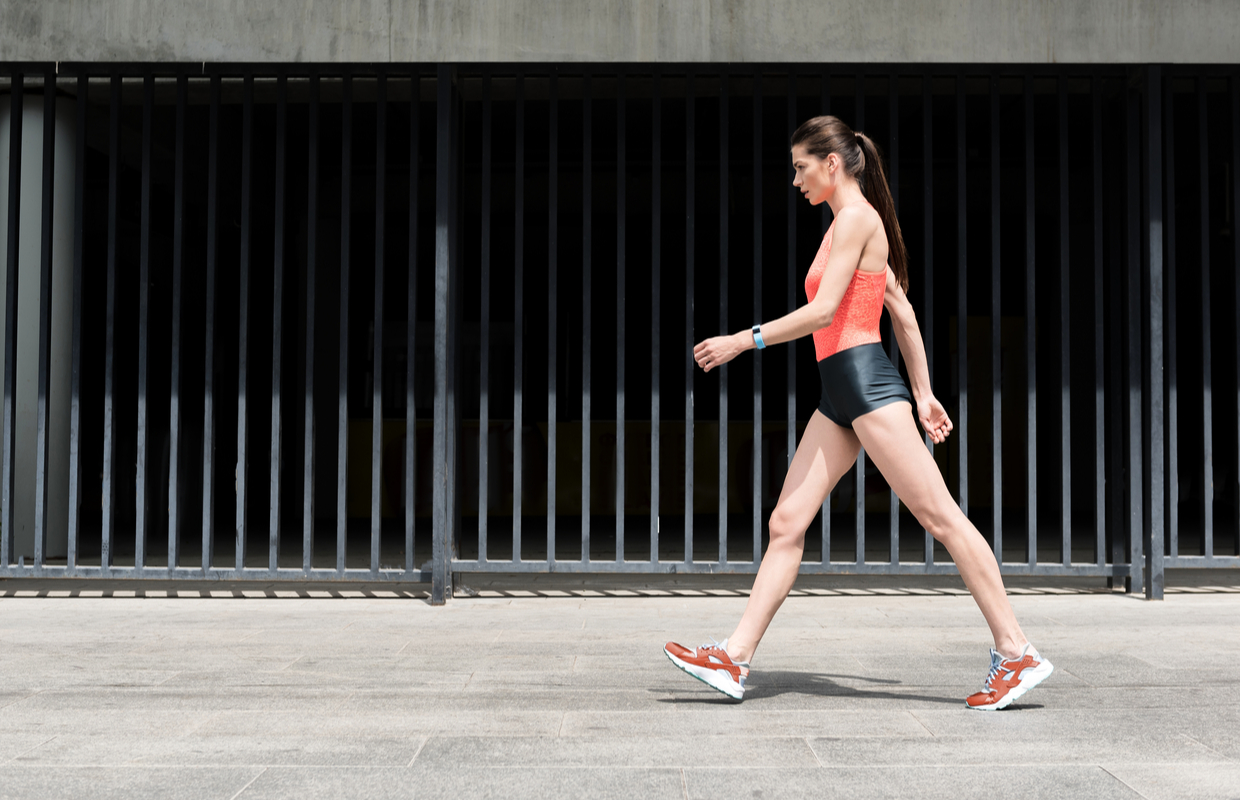Looking to turn your daily walk into a fitness workout? Discover the benefits of walking for fitness along with some top tips to help you perfect your pace, distance and technique…
Walking ticks every box when it comes to your health, fitness and wellbeing. Not only is it the most natural, affordable and convenient exercise you can do, a growing body of scientific evidence confirms it offers a wealth of benefits for your body and mind – from helping with weight management to boosting your mood.
Walking is a workout you can do all year round, anytime, anywhere – for free! It fits easily into every lifestyle – you can walk to work, in your lunch hour, while pushing a buggy in the park or with friends at the weekend. Low-impact and adaptable, walking is suitable for any age, build and fitness level. Plus, adding more walking into your life can save money and minimise public transport use or sitting in traffic!
All types of walking will help you stay healthy. However, just a few adjustments to your walking style, pace and distance can transform your fitness. Here’s how…

5 benefits of walking for fitness
1. Walking helps with weight management
Walking is the perfect exercise for weight management and toning your body as it engages the same major muscle groups as running, but creates less impact on your joints.
Plus, not only does data show you’re more likely to maintain a healthy weight and have a lower BMI if you take a brisk 30-minute walk every day (compared with another vigorous workout), but walking is also the one activity you’re likely to stick with for the rest of your life.
2. A brisk walk burns calories and strengthens muscles
Walking burns plenty of calories, whatever pace you stick to. However, researchers at the University of Virginia in the US have found that brisker walks showed greater results.
The research team compared women who did three shorter, faster-paced walks a week (plus two longer, moderately-paced walks) with a group of women who walked every day at strolling pace. Although all the women burned around the same number of calories – 400 per workout – those who walked faster lost over two inches from their waistlines, compared to just half an inch in the slower walkers.
If you’re looking to upgrade your walks, why not try hill walking or mountain hiking? These walking workouts burn around 405 calories per hour, while also working hamstrings, quads, glutes and calf muscles. Alternatively, try Nordic walking (using poles. This burns up to 400 calories an hour while also working your arms, shoulders, chest and upper back.
3. Walking can help to prevent a range of health conditions
Walking offers a host of preventative and curative benefits for your body and mind. It’s been shown to prevent conditions ranging from heart disease to sleep problems. It can help lift depression, reduce high blood pressure and even cut cigarette cravings. So great are the benefits of daily walking, it’s been described as being as close to a magic bullet as you’ll find in modern medicine.
4. Walking can reduce your stroke risk
Walking for at least two hours a week could reduce your risk of stroke by 30 percent. This increases to 37 percent if you walk at a fast pace, according to a study published in the Journal of the American Heart Association.
5. Reduce your diabetes risk with walking
The odds of developing type 2 diabetes decreases the more you walk if you clock up 15K or more per week. And if you already have diabetes, the further you walk, the less likely you’ll need anti-diabetic drugs.

Best walking pace to improve your fitness
Even walking at a regular two-mile-an-hour rate is proven to aid healthy weight loss. But, if you want real fitness benefits, you need to up your pace so you’re pushing your cardiovascular and muscular systems. Brisk walking also increases your ‘afterburn’ – the number of calories your body burns after your workout, when you’re at rest – by almost 50 per cent compared with a slower, more ambling walking style.
Most of us walk at about two miles an hour if strolling or about two to three miles an hour if out shopping or commuting. To improve your fitness and reach a healthier weight, you need to up your pace to four or five miles an hour, an effort where you’ll feel slightly out of breath. This faster pace naturally engages your arms, and the more you swing your arms, the faster you can walk.
Walking at this pace, you’ll complete a mile in about 12 to 14 minutes. This difference in intensity and effort pays you a big reward, giving you all the weight-loss and toning benefits. As you get fitter, you’ll find your speed will naturally increase. The harder you work, the better the results! Walking should be an aerobic exercise to ensure your muscles have sufficient oxygen. If you’re gasping for breath and unable to hold a conversation, you’re doing anaerobic exercise, so slow down a little.
How far do you need to walk to improve your fitness?
While 10,000 steps a day (about five miles) is the target for health benefits, if walking is the mainstay of your exercise regime, you ideally need to do more than 10,000 steps, incorporating bursts of speed over time. This may sound a lot but during a 30-minute walk, you can easily take anywhere between 2,000 and 6,000 steps, and you’ll still have the rest of the day to build up to your 10,000 step goal.
Once you’ve established your baseline number of steps, you can build up your total gradually. Try adding 500 steps a week by building a bit more time into your day for walking – you’ll be amazed how quickly the steps add up.
Varying the terrain you walk on will increase the fitness benefits. Walking on softer surfaces, such as grass, uses more energy than walking on concrete. Adding hills also boosts the benefits – on steep inclines, your heart rate can increase by 20 per cent, meaning more calories burned. When you walk downhill, your leg muscles have to work against gravity to slow your descent.

Walking for fitness: 6 technique tips
Correct form will help you walk more comfortably, improve your fitness and stay injury free. Follow these guidelines to perfect your stride…
- Stand tall and keep your neck long. This allows your spine to relax and rotate. Keep your head in line with your spine and your chin parallel to the ground – any other position and will interfere with your stride.
- To perfect your walking posture, imagine a vertical line from your big toe to the centre of your knee and up to your pelvis.
- Keep your abs slightly contracted. Imagine your pelvis contains a bowl of water and aim not to spill any as you walk. This supports your back, flattens your tummy and reduces pressure on your joints.
- Take shorter rather than longer strides – this will be better for your joints as well as your posture.
- Strike the ground with your heel and roll your foot through to your toes, then focus on pushing off from the ground through all your toes. This will help to engage your glute muscles.
- Walking with straight arms will impair your technique and make you walk slower. Bend your arms slightly and swing them back and forwards like a pendulum. This helps propel you forward. The faster you swing your arms, the faster your legs will move.







